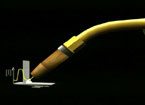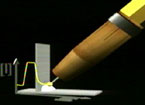High-speed video technology is of particular importance for research in the field of welding equipment. In collaboration with Fronius Schweißmaschinen KG Austria and the Christian Doppler Laboratory under the direction of Prof. Dr. Gustav Pomberger, the Ars Electronica Futurelab developed a CAVE application that visualizes with up to 8,000 images/second the droplet formation within an arc during a weld. The aim of this multi-phase project was the development of a video-based voltage flow synchronization procedure to enable Fronius’ R&D lab to precisely analyze the interplay of the various magnitudes that affect a weld. Plus, a stereographic computer simulation can be run in order to make the results of these analyses clearer as well as understandable by laymen.
The Digital Scope Video Analyzer is an analysis and archiving tool for welding procedures recorded in the lab. Thanks to a special video card, the droplet formation process along with all pertinent data can be played back in slow motion so that different trial runs and their respective values can be compared. The recorded images and data, which can be synchronously controlled, make use of specially developed functions that enable analysts to evaluate a welding procedure much more precisely and in a fraction of the time as compared to previous methods.
The project also served as a test to evaluate the extent to which a CAVE environment was suited to conveying complex content and information.
Technology:
DSVA: a PentiumPro communicates with a Kodak HighSpeed camera and whichever digital scopes are employed in the respective procedures. The video recording and playing are done with a video card by DPS.
VR Application: an SGI Onyx Deskside (RE II) controls an ImmersaDesk (stereographic 3-D projection). A 6-DOF tracker and shutter-glasses also come into play. The application itself was created with Performer.
In cooperation with: C. Doppler Laboratory for Software Engineering of the Johannes Kepler University and Fronius Schweißmaschinen KG Austria.
| |
|
|
|
|
||

